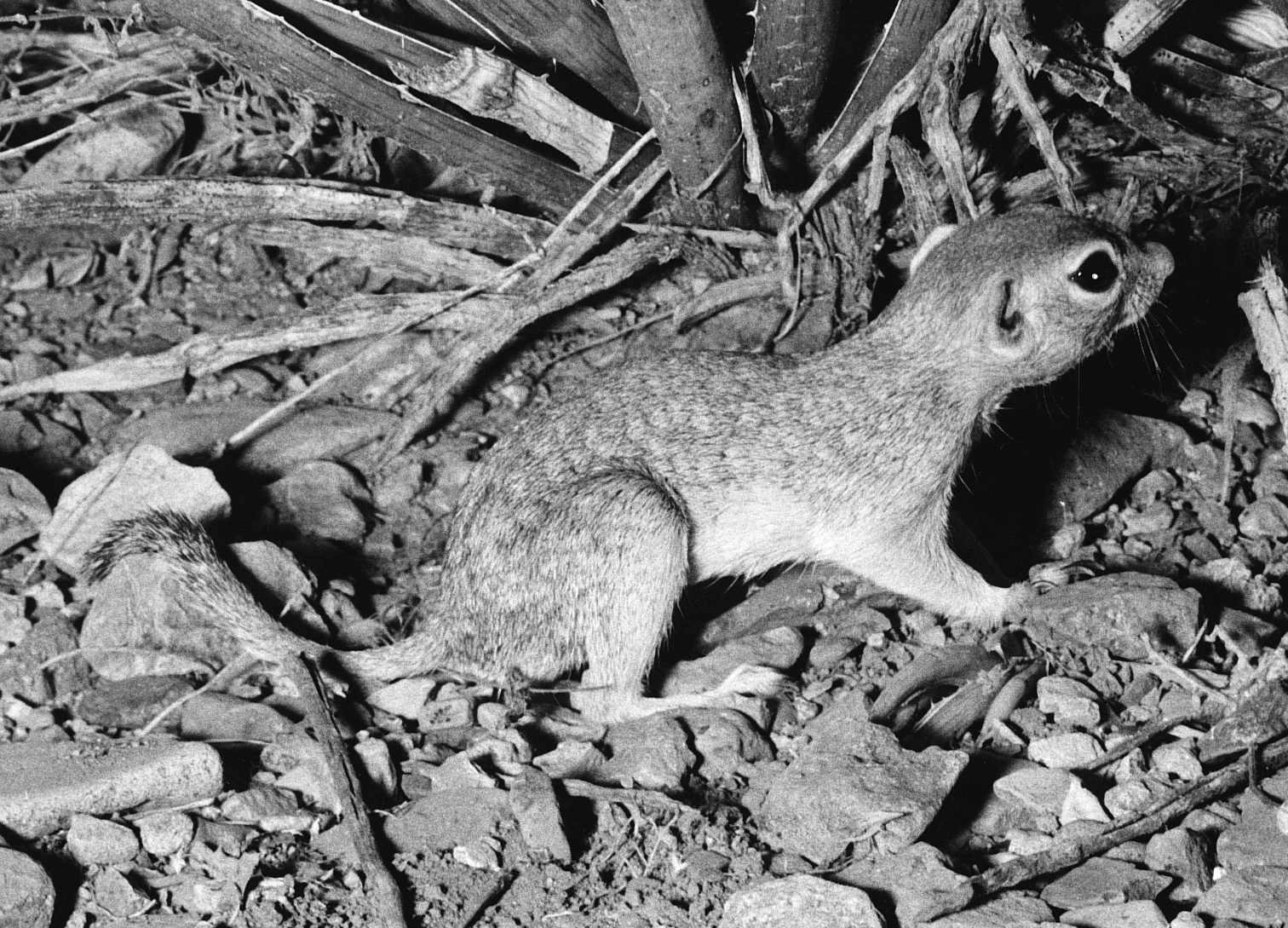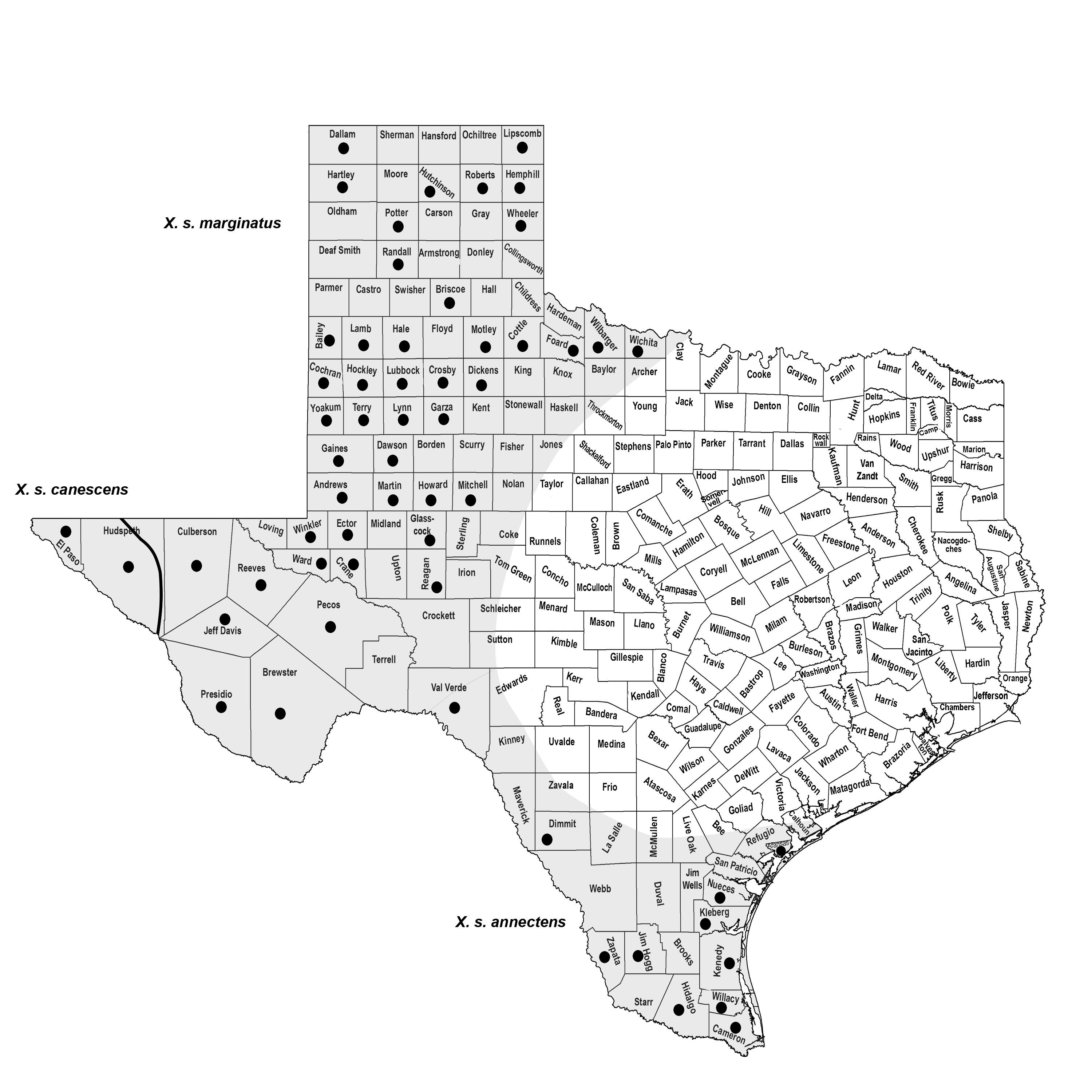SPOTTED GROUND SQUIRREL
Xerospermophilus spilosoma (Bennett 1833)
Order Rodentia : Family Sciuridae
DESCRIPTION. A small ground squirrel (previously treated as Spermophilus spilosoma; see "Remarks") with scattered, more or less squarish, light spots on back (spots not in rows as in I. parvidens and I. tridecemlineatus); ears inconspicuous; tail about one-third of total length, pinkish buff or cinnamon buff beneath; upperparts smoke gray, light drab, or fawn color, the white spots small and obsolete, especially on shoulder; underparts white. Dental formula: I 1/1, C 0/0, Pm 2/1, M 3/3 × 2 = 22. Averages for external measurements: total length, 214 mm; tail, 65 mm; hind foot, 32 mm. Weight, 100–125 g.

DISTRIBUTION. Known from western half of state and southward on Rio Grande Plains. It is uncommon and restricted to the western edge of the Edwards Plateau in Crane, Glasscock, Howard, Reagan, and Val Verde counties.

SUBSPECIES. Xerospermophilus s. annectens in the southern part of the state, X. s. canescens in the western Trans-Pecos, and X. s. marginatus in the remainder of the range.
HABITS. Spotted ground squirrels seem to prefer dry, sandy areas, but they are also found in grassy parks, open pine forests, scattered brush, and occasionally on rocky mesas. Disturbed areas along highways and roads also are utilized, as well as areas along the sides of arroyos and overgrazed pastureland. On Mustang Island, off the coast of Texas, they live in the sand dunes and share their runways through the sparse vegetation with kangaroo rats, grasshopper mice, and other small rodents. Near Van Horn they are rather common in the sandhills covered with yuccas and other desert shrubs, and in the southern part of the Big Bend they occur in small numbers on rather hard ground covered with creosote bushes. The opening to their burrows is usually under bushes or overhanging rocks. One excavated burrow had three openings, was about 4 m long, descended no more than 50 cm, and terminated in a nest chamber. A burrow in the Big Bend had an opening about 5 cm in diameter and was marked by a slight mound. On the Llano Estacado, burrows often are placed near the base of brushy vegetation such as mesquite, shinnery oak, or sand sage, and individuals occasionally inhabit developed areas such as golf courses.
These squirrels are extremely shy. One can work in an area several days without seeing them. They are most active in early morning and late afternoon to avoid the midday heat. They seldom go far from their burrows and retreat to them at the slightest sign of danger. Their movements are rapid and interrupted by abrupt stops. In running, the body and tail are held close to the ground.
Hibernation probably is not obligate in these squirrels, especially in the southern part of their range, but their activity is severely curtailed during cold weather. Specimens have been taken in November through February in Texas. Xerospermophilus spilosoma also may estivate during hot, dry periods.
Their food is largely green vegetation and seeds. Specific items are cactus pulp, mesquite beans, saltbush seeds, sandbur, sunflower, gourd, iris, grasshoppers, and beetles. Insects are included in the diet during times of abundance, and these ground squirrels have even been observed feeding on lizards and kangaroo rats.
Their breeding habits are not well known. Females captured in mid-June, at which time half-grown young were common, contained five to seven embryos. This indicates that two litters may be reared yearly. Young, presumably about 1 month old, have been observed aboveground as early as 28 April and as late as 17 September, which would suggest that mating begins in February and continues into mid-July. The gestation period is not known but is probably about 30 days. Six young spotted ground squirrels reared in captivity were found to weigh an average of 17 g at 34 days of age, their eyes opened at 27–28 days, and they were weaned at about 48 days.
POPULATION STATUS. Common. The spotted ground squirrel is common throughout the western portion of the state.
CONSERVATION STATUS. The IUCN recognizes the spotted ground squirrel as Spermophilus spilosoma instead of Xerospermophilus spilosoma and lists it as a species of least concern. It does not appear on the federal or state lists of concerned species. This species remains in good shape throughout its range in Texas.
REMARKS. Formerly included as Spermophilus spilosoma. a 2009 taxonomic revision by Chris Helgen and colleagues (Smithsonian Institution) necessitated placement of the spotted ground squirrel into the genus Xerospermophilus.
From The Mammals of Texas, Seventh Edition by David J. Schmidly and Robert D. Bradley, copyright © 1994, 2004, 2016. Courtesy of the University of Texas Press.
Natural Science Research Laboratory
-
Address
Museum of Texas Tech University, 3301 4th street, Lubbock, TX 79409 -
Phone
806.742.2486 -
Email
nsrl.museum@ttu.edu

